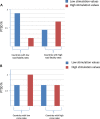Differences in prevalence rates of PTSD in various European countries explained by war exposure, other trauma and cultural value orientation
- PMID: 24972489
- PMCID: PMC4114166
- DOI: 10.1186/1756-0500-7-407
Differences in prevalence rates of PTSD in various European countries explained by war exposure, other trauma and cultural value orientation
Abstract
Background: Guided by previous explorations of historical and cultural influences on the occurrence of PTSD, the aim of the present study was to investigate the contributions of war victimisation (in particular, World War II) and other civil trauma on the prevalence of PTSD, as mediated by cultural value orientation. Secondary data analysis was performed for 12 European countries using data, including PTSD prevalence and number of war victims, crime victims, and natural disaster victims, from different sources. Ten single value orientations, as well as value aggregates for traditional and modern factors, were investigated.
Results: Whilst differences in PTSD prevalence were strongly associated with war victim rates, associations, albeit weaker, were also found between crime victims and PTSD. When cultural value orientations, such as stimulation and conformity as representatives of modern and traditional values, were included in the multivariate predictions of PTSD prevalence, an average of approximately 80% of PTSD variance could be explained by the model, independent of the type of trauma exposure.
Conclusion: The results suggest that the aftermath of war contributes to current PTSD prevalence, which may be explained by the high proportion of the older population who directly or indirectly experienced traumatic war experiences. Additional findings for other types of civil trauma point towards an interaction between value orientation and country-specific trauma rates. Particularly, being personally oriented towards stimulation appears to interact with differences in trauma prevalence. Thus, cultural value orientation might be viewed not only as an individual intrinsic process but also as a compensatory strategy after trauma exposure.
Figures


Similar articles
-
Traditional versus modern values, self-perceived interpersonal factors, and posttraumatic stress in Chinese and German crime victims.Psychol Psychother. 2009 Jun;82(Pt 2):219-32. doi: 10.1348/147608308X380769. Epub 2008 Nov 26. Psychol Psychother. 2009. PMID: 19040793
-
[The Gulf War Syndrome twenty years on].Encephale. 2013 Oct;39(5):332-8. doi: 10.1016/j.encep.2012.11.003. Epub 2013 Jan 23. Encephale. 2013. PMID: 23351934 Review. French.
-
Post-traumatic Stress Disorder.Int J Occup Environ Med. 2012 Jan;3(1):2-9. Int J Occup Environ Med. 2012. PMID: 23022845 Review.
-
PTSD prevalence among Polish World War II survivors.Psychiatr Pol. 2016 Oct 31;50(5):923-934. doi: 10.12740/PP/OnlineFirst/60171. Psychiatr Pol. 2016. PMID: 27992886 English, Polish.
-
[War trauma and PTSD among German war survivors. A comparison of former soldiers and women of World War II].Nervenarzt. 2014 Mar;85(3):356-62. doi: 10.1007/s00115-013-3794-8. Nervenarzt. 2014. PMID: 23695004 German.
Cited by
-
Traumatic stress and psychological functioning in a South African adolescent community sample.S Afr J Psychiatr. 2017 Mar 10;23:1008. doi: 10.4102/sajpsychiatry.v23i0.1008. eCollection 2017. S Afr J Psychiatr. 2017. PMID: 30263182 Free PMC article.
-
From Pathology to Intervention and Beyond. Reviewing Current Evidence for Treating Trauma-Related Disorders in Later Life.Front Psychiatry. 2022 Mar 1;13:814130. doi: 10.3389/fpsyt.2022.814130. eCollection 2022. Front Psychiatry. 2022. PMID: 35299824 Free PMC article. Review.
-
Traumatic Events and Vaccination Decisions: A Systematic Review.Vaccines (Basel). 2022 Jun 8;10(6):911. doi: 10.3390/vaccines10060911. Vaccines (Basel). 2022. PMID: 35746519 Free PMC article. Review.
-
Symptoms of PTSD in Frontline Journalists: A Retrospective Examination of 18 Years of War and Conflict.Can J Psychiatry. 2018 Sep;63(9):629-635. doi: 10.1177/0706743718777396. Epub 2018 May 23. Can J Psychiatry. 2018. PMID: 29792077 Free PMC article.
-
Psychiatric Co-Morbidities in Post-Traumatic Stress Disorder: Detailed Findings from the Adult Psychiatric Morbidity Survey in the English Population.Psychiatr Q. 2021 Mar;92(1):321-330. doi: 10.1007/s11126-020-09797-4. Psychiatr Q. 2021. PMID: 32705407 Free PMC article.
References
-
- Hinton DE, Lewis-Fenandez R. The cross-cultural validity of posttraumatic stress disorder. Depress Anxiety. 2011;28:783–801. - PubMed
Publication types
MeSH terms
LinkOut - more resources
Full Text Sources
Other Literature Sources
Medical

